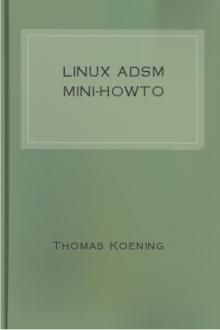ADSL Bandwidth Management HOWTO by Dan Singletary (inspirational books for students TXT) 📕

-----
3.5. Attempting to Throttle Inbound Traffic
By using the Intermediate Queuing Device (IMQ), we can run all incoming packets through a queue in the same way that we queue outbound packets. Packet priority is much simpler in this case. Since we can only (attempt to) control inbound TCP traffic, we'll put all non-TCP traffic in the 0x00 class, and all TCP traffic in the 0x01 class. We'll also place "small" TCP packets in the 0x00 class since these are most likely ACK packets for outbound data that has already been sent. We'll set up a standard FIFO queue on the 0x00 class, and we'll set up a Random Early Drop (RED) queue on the 0x01 class. RED is better than a FIFO (tail-drop) queue at controlling TCP because it will drop packets before the queue overflows in an attempt to slow down transfers that look like they're about to get out of control. We'll also rate-limit bot
Read free book «ADSL Bandwidth Management HOWTO by Dan Singletary (inspirational books for students TXT) 📕» - read online or download for free at americanlibrarybooks.com
- Author: Dan Singletary
- Performer: -
Read book online «ADSL Bandwidth Management HOWTO by Dan Singletary (inspirational books for students TXT) 📕». Author - Dan Singletary
tc class add dev $DEV parent 1:1 classid 1:25 htb rate $[$RATEUP/7]kbit ceil ${RATEUP}kbit prio 5
tc class add dev $DEV parent 1:1 classid 1:26 htb rate $[$RATEUP/7]kbit ceil ${RATEUP}kbit prio 6
attach qdisc to leaf classes - here we at SFQ to each priority class. SFQ insures that within each class connections will be treated (almost) fairly.tc qdisc add dev $DEV parent 1:20 handle 20: sfq perturb 10
tc qdisc add dev $DEV parent 1:21 handle 21: sfq perturb 10
tc qdisc add dev $DEV parent 1:22 handle 22: sfq perturb 10
tc qdisc add dev $DEV parent 1:23 handle 23: sfq perturb 10
tc qdisc add dev $DEV parent 1:24 handle 24: sfq perturb 10
tc qdisc add dev $DEV parent 1:25 handle 25: sfq perturb 10
tc qdisc add dev $DEV parent 1:26 handle 26: sfq perturb 10
filter traffic into classes by fwmark - here we direct traffic into priority class according to the fwmark set on the packet (we set fwmark with iptables later). Note that above we've set the default priority class to 1:26 so unmarked packets (or packets marked with unfamiliar IDs) will be defaulted to the lowest priority class.tc filter add dev $DEV parent 1:0 prio 0 protocol ip handle 20 fw flowid 1:20
tc filter add dev $DEV parent 1:0 prio 0 protocol ip handle 21 fw flowid 1:21
tc filter add dev $DEV parent 1:0 prio 0 protocol ip handle 22 fw flowid 1:22
tc filter add dev $DEV parent 1:0 prio 0 protocol ip handle 23 fw flowid 1:23
tc filter add dev $DEV parent 1:0 prio 0 protocol ip handle 24 fw flowid 1:24
tc filter add dev $DEV parent 1:0 prio 0 protocol ip handle 25 fw flowid 1:25
tc filter add dev $DEV parent 1:0 prio 0 protocol ip handle 26 fw flowid 1:26
add MYSHAPER-OUT chain to the mangle table in iptables - this sets up the table we'll use to filter and mark packets.iptables -t mangle -N MYSHAPER-OUT
iptables -t mangle -I POSTROUTING -o $DEV -j MYSHAPER-OUT
add fwmark entries to classify different types of traffic - Set fwmark from 20-26 according to desired class. 20 is highest prio.iptables -t mangle -A MYSHAPER-OUT -p tcp --sport 0:1024 -j MARK --set-mark 23 # Default for low port traffic
iptables -t mangle -A MYSHAPER-OUT -p tcp --dport 0:1024 -j MARK --set-mark 23 # ""
iptables -t mangle -A MYSHAPER-OUT -p tcp --dport 20 -j MARK --set-mark 26 # ftp-data port, low prio
iptables -t mangle -A MYSHAPER-OUT -p tcp --dport 5190 -j MARK --set-mark 23 # aol instant messenger
iptables -t mangle -A MYSHAPER-OUT -p icmp -j MARK --set-mark 20 # ICMP (ping) - high prio, impress friends





Comments (0)